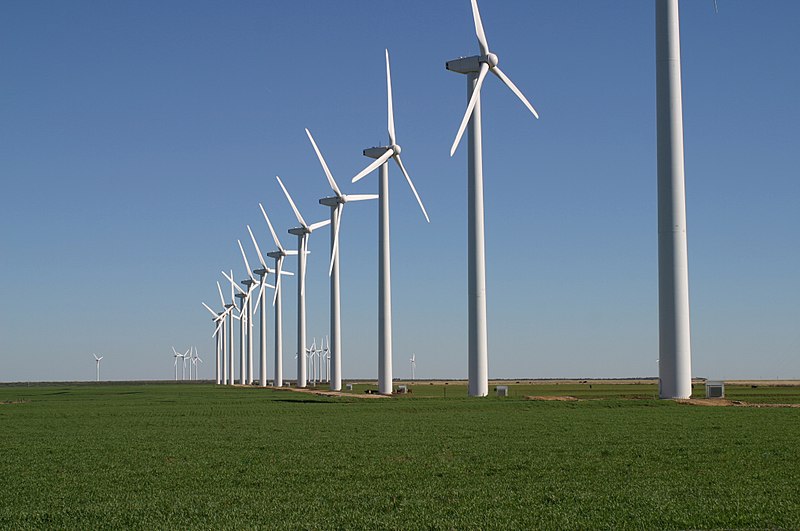 |
| Source: Wikipedia |
Amongst the various energy options such as nuclear and fossil fuels, most would likely consider wind power as a relatively climate-friendly technologies. The New York Times in Oct 2013 reported that 12 miles off the coast of Fukushima nuclear power plant site, a giant floating wind turbine has been installed that can generate enough electricity to power 1,700 homes. Japan aims to have 140 of such wind turbines that would generate one gigawatt of electricity. This is equivalent to the power generated by one nuclear reactor.However, the perception of wind power being climate-friendly is now being challenged.
The Telegraph in Apr 2012 reported on a study which postulated that wind farms could result in localised climate changes. The paper by Zhou et al (2012) presented observational evidence for the period of 2003–2011 over a region in west-central Texas, where four of the world’s largest wind farms are located. The analysis revealed a significant warming trend of up to 0:72 degrees Celsius per decade over wind farms. Interestingly, the spatial pattern of the land surface temperature increase (red areas) correlates well with the geographic distribution of wind turbines, as shown in the chart below.
 |
| Source: Zhou et al (2012) |
Most of the wind farms were built around 2005-2008, so the temperature difference depicted is for the years before (2003) and after (2010) the wind farms were constructed.
On a separate note, the US EPA has cited other concerns on the use of wind power. Modern wind towers can be between 60-120m in height and are typically sited on atop ridgelines or in the sea. Wind facilities may sometimes face opposition from local communities due to aesthetics considerations, as well as its impact on wildlife such as birds. Recently, the Washington Post reported that the US government fined a wind farm in Wyoming a hefty sum of S1 million for the deaths of eagles in turbines under the Migratory Bird Treaty Act.
Wind farms are also subject to availability of the wind resource, and consumers have to fall back on conventional sources of power that may contribute GHG when there are no winds*, The latest finding by Zhou et al (2012) would further trigger the need to rethink the modes by which some of our climate-friendly technologies could create localised impact on the regional climate.
*Updated on 28 Nov 2013
hmm interesting. I wonder whether there any studies that look at the localised climate effects of fossil fuel-powered energy production - I'm from Oxford and we always used to joke that the nearby town of Didcot (which is home to a massive coal and gas power plant) had it's own microclimate! I guess in comparison to fossil fuel power stations, the climate impact of wind turbines is likely to occur over a larger region and therefore the cumulative effect might be higher. Still, I don't think equating localised warming with climate change is justified.
ReplyDeleteI worry that studies such as Zhou et al (2012) will just be used become another weapon for NIMBYs who oppose wind farm development. I read a really interesting article on BBC news the other day which observes that, no matter what energy type, it seems impossible to make people happy and thought you might find it interesting: http://www.bbc.co.uk/news/science-environment-24985531
Hi Agnes, thank you for sharing the interesting article. You have raised a very good point about NIMBYs. I believe no matter which energy option, there will always be trade-offs. There is thus a need to weigh the pros and cons and policy makers will have to make the hard decisions for the greater good.
DeleteIt appears that studies on fossil fuel power stations are largely on the environmental and health impacts, and I hardly come across any studies focussing on localised climate effects. However, I did come across a paper on climate change litigation that could give us a glimpse of some of the difficulties in assigning responsibility for climate change to a particular power plant. Here's the link if you are interested to have a look.
http://www.ucl.ac.uk/laws/environment/docs/hong-kong/Issues%20in%20Climate%20Change%20Litigation%20(Jacqueline%20Peel).pdf
Hi Joon, interesting post, I never considered the effects on regional climate. One thing you say though I would like to refute: "While wind farms do not contribute GHG emissions directly, the latest finding by Zhou et al (2012) does trigger the need to rethink the modes by which some of our climate-friendly technologies could create localised impact on the regional climate."
ReplyDeleteWind farms do actually contribute to GHG emissions, not entirely directly, but still. Especially here in the UK and in the Netherlands and Germany. Because of how inconsistent the amount of wind is, so is energy generation. On wind still days, the power demand remains the same and power has to come from somewhere, due to our problem of lack of storage. For large wind turbine projects, for every available MW of wind power, 0.95 MW of 'traditional' (fossil fuel) power has to be available stand-by. At the moment this is done with driving the energy production by gas generators up and down according to wind availability, lowering the efficiency of these gas power plants to such an extent that if the 12 GW wind park in the Netherlands is realized, Dutch CO2 emissions will actually increase because of it.
I have a great article on this, but unfortunately it's in Dutch. I'll see whether I can find a translation!
Hi Larissa, thank you for the comment! If the lack of wind availability may actually cause an increase in CO2 emissions, then this is certainly a major factor that must be taken into consideration. I will update the blog to take note of this point. Tks!
Delete